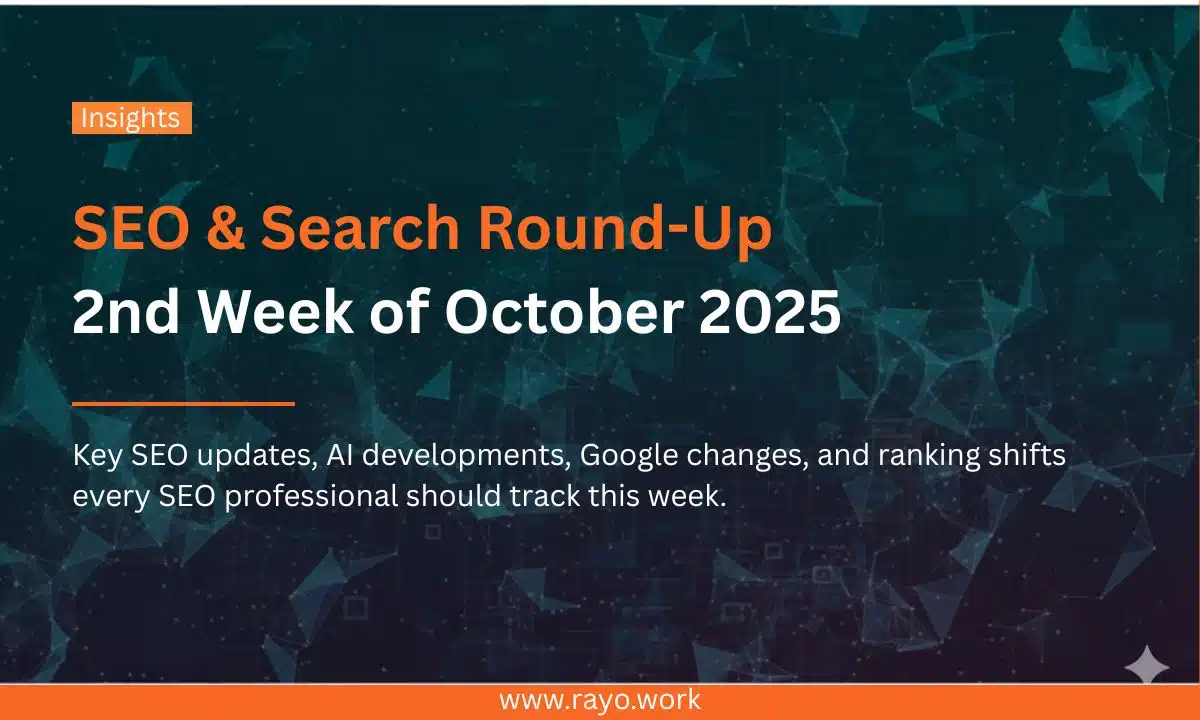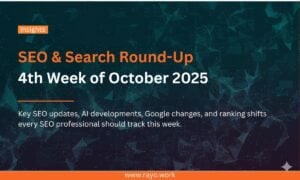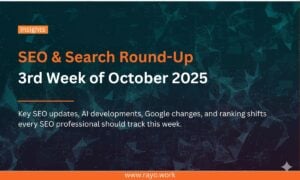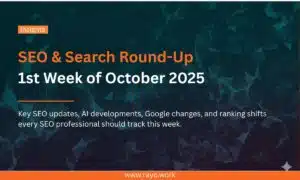The second week of October proved that search never sleeps. From Google’s expanding AI footprint and infrastructure hiccups to OpenAI’s new agent-building toolkit and Perplexity’s AI-powered browser launch, the landscape continues to evolve faster than most teams can keep up.
Ranking volatility kept SEOs on edge, while new experiments like Google’s unconfirmed “Show More” AI test and broader AI Mode rollout hint at a deeper shift in how users will discover and interact with information.
Below are the key developments from this week, and what they mean for your strategy.
1. Google Search Ranking Volatility Heats Up (Oct 7–8)
What happened: Major ranking fluctuations were recorded across multiple verticals during Oct 7–8. While Google hasn’t confirmed a core update, volatility charts spiked globally, leaving SEOs watching the SERPs nervously.
Here’s how key tracking tools captured the movement.
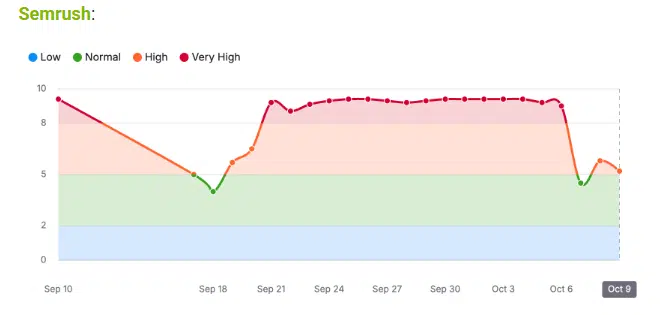
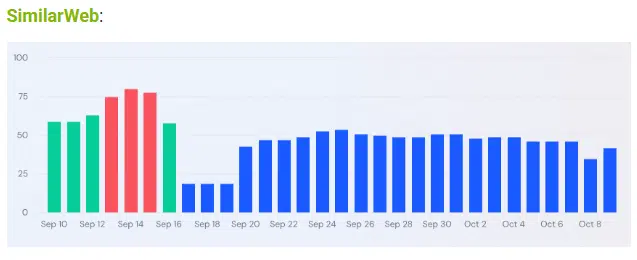
Why it matters: Sudden turbulence can skew performance insights and make attribution messy. A “stable keyword set” can vanish overnight.
What to do:
- Avoid hasty changes, track for a few days before reacting.
- Compare data across multiple rank trackers.
- Audit pages that gained or lost traffic to uncover common patterns.
2. Google Confirms Search Serving Issue (Data Centre Problem)
What happened: A short-lived technical outage at one of Google’s data centres early this month disrupted search serving in select regions, temporarily affecting visibility.
Google posted about this on Bluesky:
Why it matters: Drops during that period may not reflect algorithmic penalties but infrastructure-level downtime.
What to do:
- Match analytics anomalies with known outage dates.
- Keep an “incident log” for client transparency.
- Always verify issues through the official status dashboard before making changes.
3. Google AI Mode Expands to 35 New Languages and 40 Countries
What happened: Google extended AI Mode access to over 35 new languages and 40 additional countries, bringing total coverage to more than 200 regions.
Rajan Patel from Google said on X:
Why it matters: AI-powered search is now available in multiple languages. Localisation and language-specific optimisation are becoming non-negotiable for global visibility.
What to do:
- Translate and culturally adapt high-value pages.
- Enrich local content with FAQs and examples relevant to new audiences.
- Track traffic trends from newly activated regions.
4. Google Tests “Show More” in AI Overviews, Jumping Directly into AI Mode
What happened: Google is reportedly testing a “Show More” button that sends users directly into AI Mode instead of expanding the current overview. However, this feature has not been officially confirmed by Google.
Why it matters: This could reduce exposure for publishers by skipping intermediate snippet views, lowering CTRs.
What to do:
- Optimise the first 150 words of content to deliver quick, AI-friendly answers.
- Keep structured data precise and current.
- Track CTR differences as the feature rolls out.
5. OpenAI Launches AgentKit for Building & Optimizing Agents
What happened:
OpenAI released AgentKit, a toolkit enabling developers and enterprises to build, deploy, and refine agents more efficiently. It includes a visual workflow builder (Agent Builder), a connector registry, ChatKit for embedding agent UIs, and expanded evaluation tools for measuring agent performance.
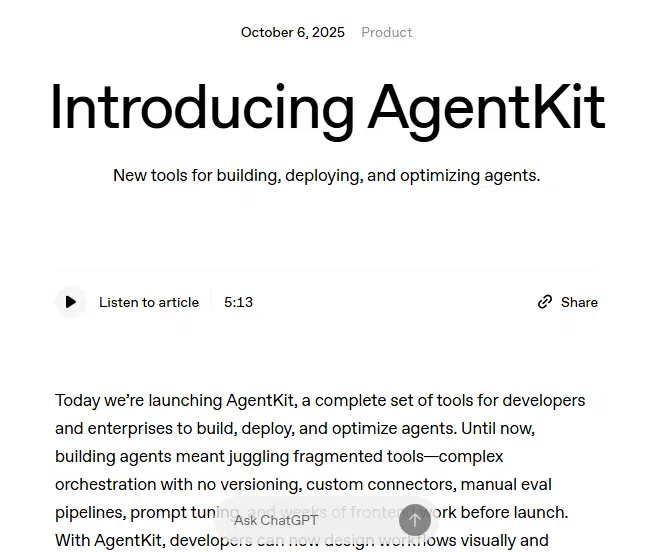
Why it matters:
As search and discovery increasingly shift toward agentic / AI-assisted interfaces, AgentKit gives creators better control over how their content and logic are surfaced and executed. This could influence how AI search systems prioritize or interact with content behind the scenes.
What to do:
- If you work with AI/chatbot systems, explore AgentKit to test how your content or logic might be surfaced in agent workflows.
- Think of site features, FAQs, and content modules as “agentable”, meaning pieces that an agent could call or embed.
- Monitor how agent deployments evolve in AI search interfaces, and how that may impact your content visibility or interaction design.
6. Perplexity Launches Comet Browser Worldwide for Free
What happened: Perplexity introduced its Comet Browser, integrating AI-powered search directly into browsing and releasing it globally at no cost.
Why it matters: This marks the rise of AI-native browsing, where discovery and answers happen without Google.
What to do:
- Check how your content is summarised in Perplexity’s results.
- Craft clean, factual summaries in your pages to improve AI reuse.
- Start tracking new referral patterns from AI-centric browsers.
Other Great Search Threads (2nd Week of October 2025)
- YouTube Tests AI-Powered Visual Search — YouTubeInsider on X
→ YouTube is experimenting with visual search, allowing users to find products and topics directly from screenshots and video frames. (link) - Google Voice Search Gets Smarter — Gagan Ghotra on LinkedIn
→ A major update for Google Voice Search is on the horizon, integrating advanced Gemini capabilities to make voice queries more contextual and conversational. (link) - Canonical Confusion Cleared — John Mueller on Bluesky
→ John clarified that even imperfect canonical setups can still guide Google’s indexing, but duplication may delay results. (link) - Google’s NanoBanana & Veo3 Breakthroughs — Philipp Schindler on LinkedIn
→ Google’s SVP highlighted new AI breakthroughs in multimodal understanding, hinting at their potential to transform content creation and advertising. (link)

Ridam Khare is an SEO strategist with 7+ years of experience specializing in AI-driven content creation. He helps businesses scale high-quality blogs that rank, engage, and convert.
